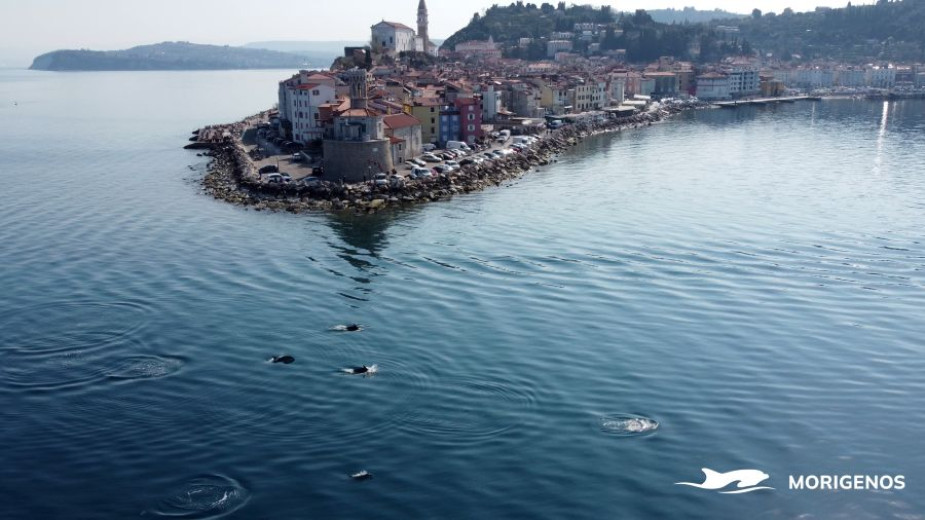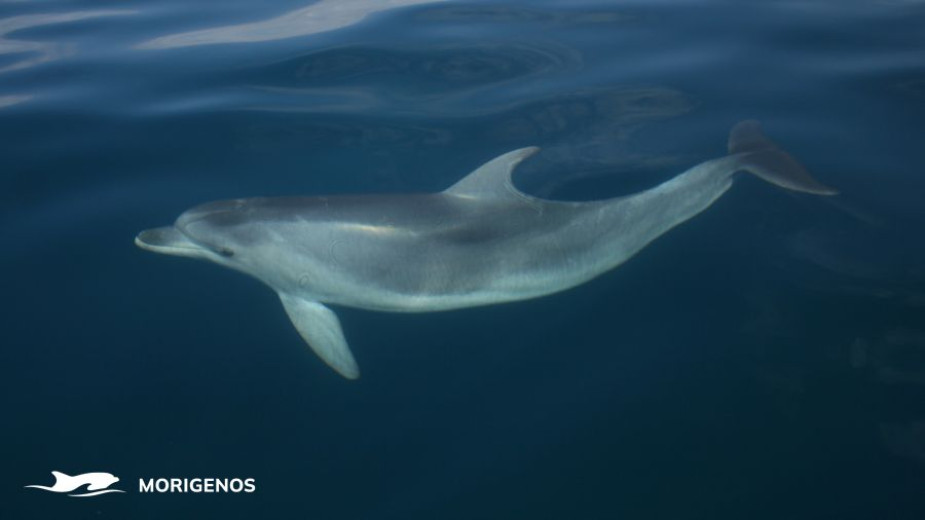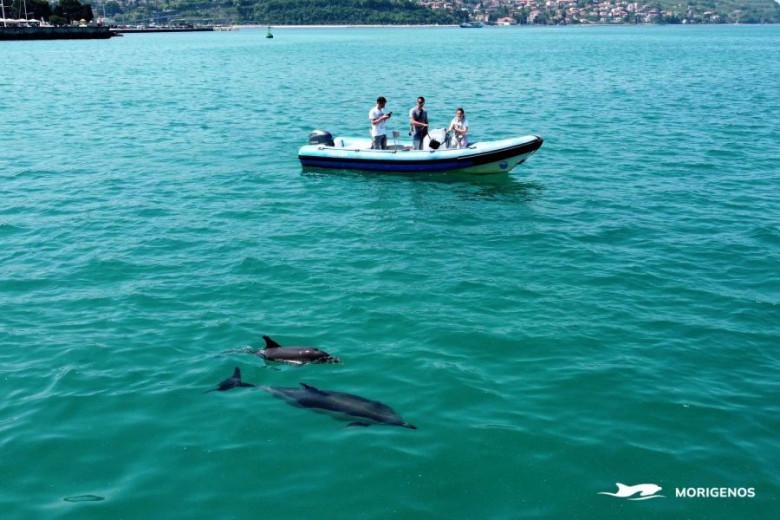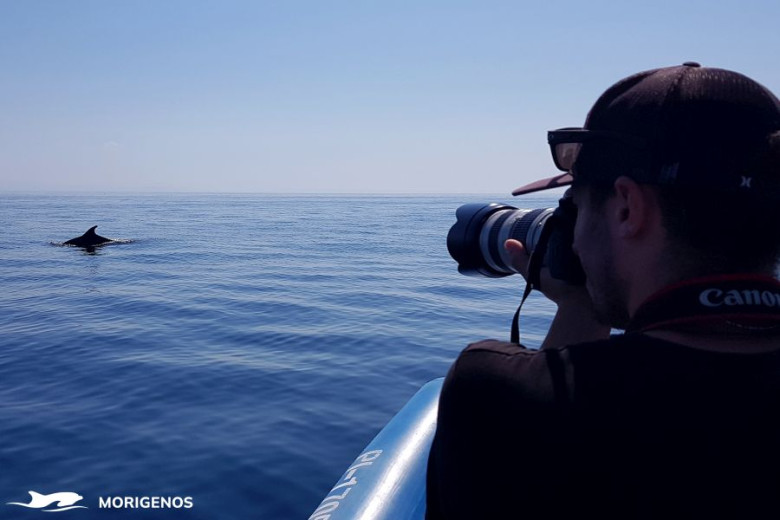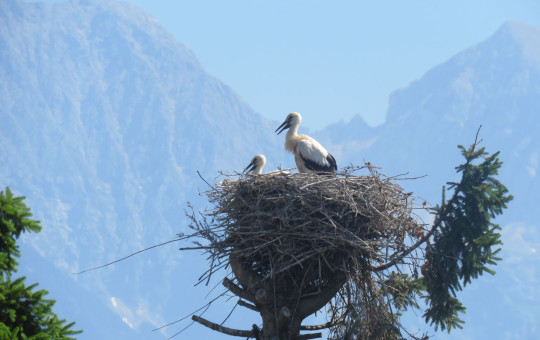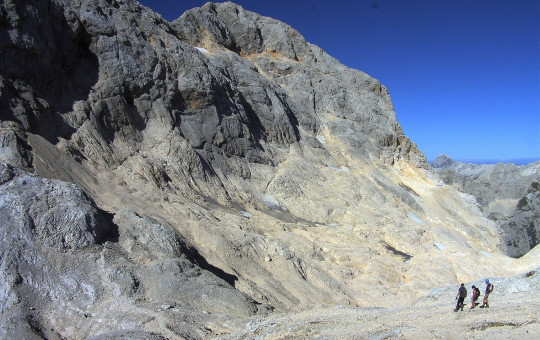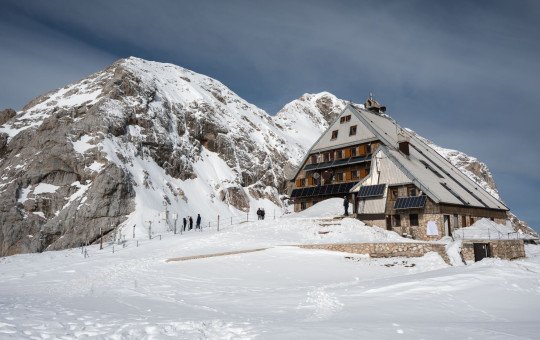Date: 4. July 2025
Time to read: 2 min
Despite its small size, the Slovenian sea hides a wealth of life. Did you know that it is also home to dolphins? Researchers have so far observed around 400 dolphins in the Slovenian sea, with some 150 living there permanently. The only resident species found in the waters along the Slovenian coast and elsewhere in northern Adriatic is the common bottlenose dolphin (Tursiops truncatus). For more than 20 years, experts from the Morigenos Slovene Marine Mammal Society have been monitoring the species, studying their behaviour, movement and life.
Dolphins live in groups known as pods. The pods spotted in the Gulf of Trieste gather at specific times: one pod visits the waters off Piran in the morning, the other in the evening. The two pods do not mix. Such behaviour has not been observed in dolphins anywhere else in the world. Dolphins are not just occasional visitors to the Slovenian sea – they also breed, raise their young, feed, rest and socialise here.
Did you know that the best land observation point on the Slovenian coast is the bell tower of the church overlooking Piran? In good weather, the entire gulfs of Piran and Trieste can be seen from there.
The dorsal fin as a fingerprint
Just as any fingerprint is unique, the same holds true for dorsal fins. Not only do they differ in shape, but also an indicate how turbulent the lives of dolphins are, as throughout their lives they accumulate cuts, scars and scratches through playing, fighting and encounters with other animals and vessels, making each fin very unique.
Researchers can identify individual dolphins and name them through observation and photo identification. The Slovenian sea is thus home to Daphne, Morigenos, Danny, and Foki, and others. Researchers find it crucial to be able to distinguish between individual dolphins, as this allows them to track their movement, determine their social structure, and count them. In this way, they can also estimate their fertility rate, annual survival rates, behaviour, and occurrence patterns. The data collected is also valuable for planning measures and protecting these exceptional marine mammals.
The Morigenos Society has found that dolphins can also be distinguished from each other by their faces, as their features differ.
Dolphins are natural indicators of marine environment health
As dolphins are predators at the top of the marine food chain and have a life span of 30 to 40 years, they are a good indicator of the state of the marine environment. Observing the dolphin population facilitates the monitoring of the health of the ecosystem they live in. The wider area of the Gulf of Trieste, approximately one third of which is the Slovenian waters, is an important part of their natural habitat. Research has shown that the dolphin population in the Gulf of Trieste is stable.
-
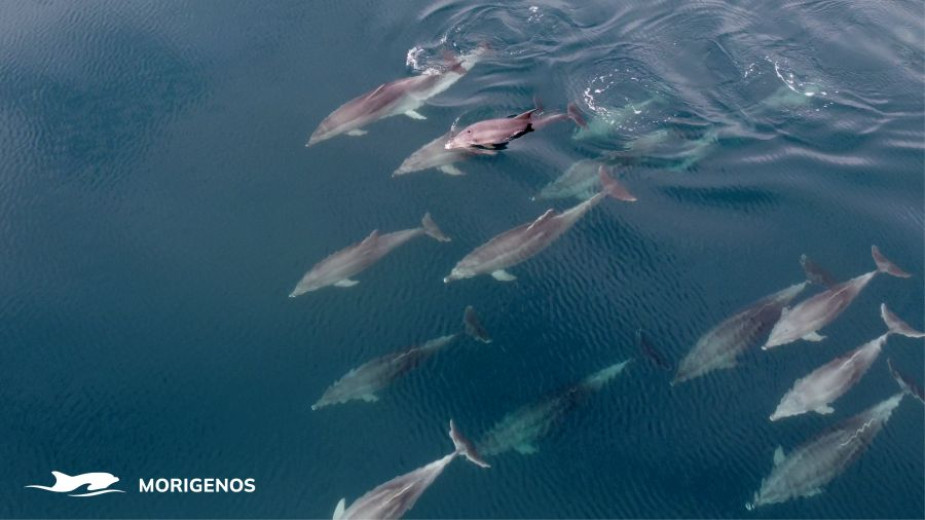 Dolphins are one of the most social animal species, they live in groups known as pods. Photo: Morigenos
Dolphins are one of the most social animal species, they live in groups known as pods. Photo: Morigenos
-
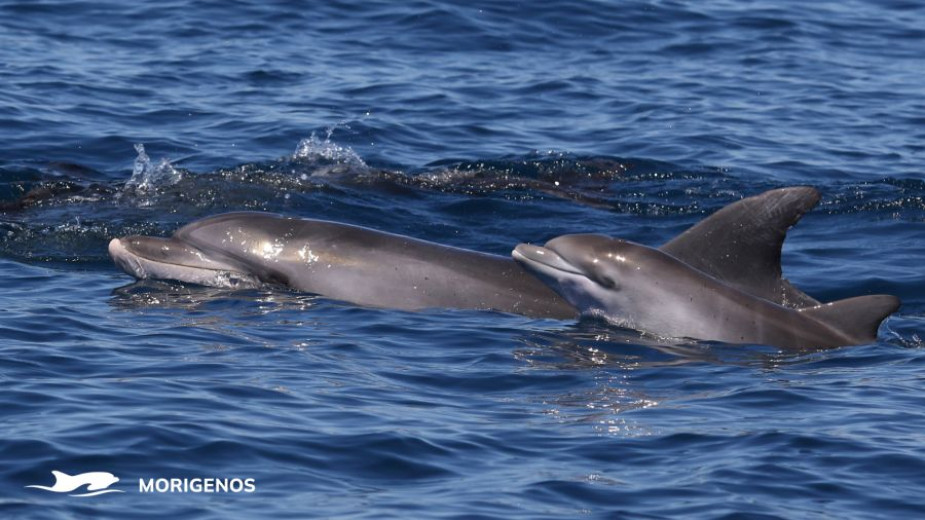 Because dolphins have long lifespans and are top predators in the food chain, monitoring their populations allows researchers to indirectly assess the health of the environment they live in. Photo: Morigenos
Because dolphins have long lifespans and are top predators in the food chain, monitoring their populations allows researchers to indirectly assess the health of the environment they live in. Photo: Morigenos
Interesting facts about dolphins
Dolphins are one of the most intelligent and social animal species. In the first few months of life, each dolphin develops its own unique signature whistle. These whistles hardly change during their lifetime. Did you know they can recognise their own reflection in a mirror? Typically, they eat between four and five kilogrammes of fish a day. For even more interesting facts about dolphins, visit The Dolphin Centre, a scientific and educational establishment in Piran, where visitors themselves can step into the shoes of dolphin researchers.
-
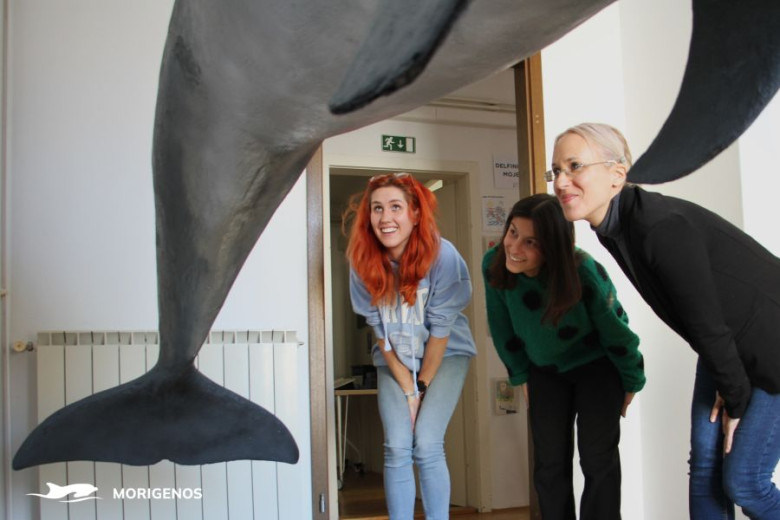 The Dolphin Centre features interesting and educational facts about dolphins. Photo: Morigenos
The Dolphin Centre features interesting and educational facts about dolphins. Photo: Morigenos
-
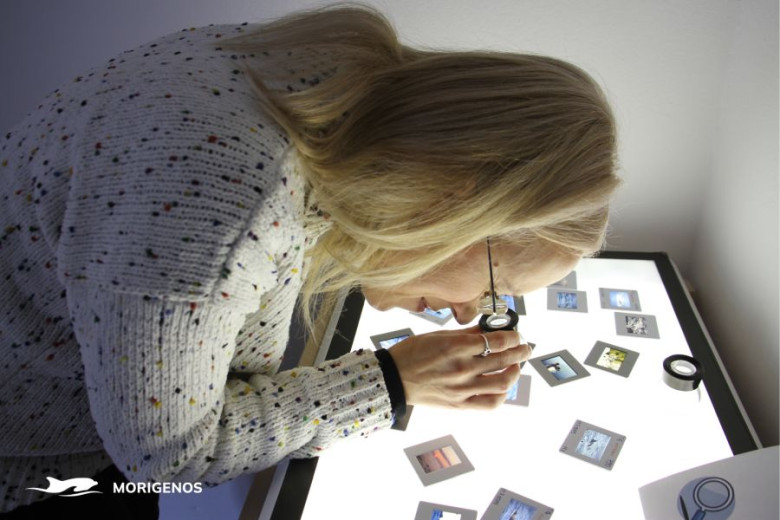 In The Dolphin Centre you can step into the shoes of dolphin researchers. Photo: Morigenos
In The Dolphin Centre you can step into the shoes of dolphin researchers. Photo: Morigenos
-
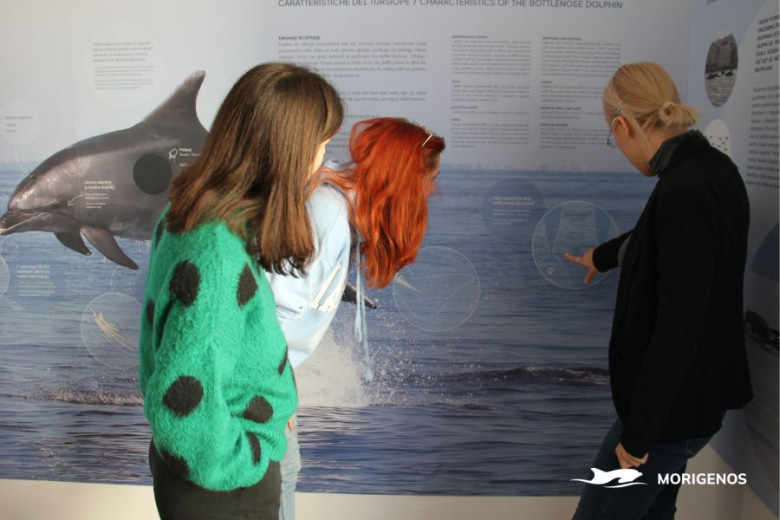 Did you know? Common bottlenose dolphin is quite a big animal. Those in the northern Adriatic measure about 3 meters and weigh around 230 kilograms. Photo: Morigenos
Did you know? Common bottlenose dolphin is quite a big animal. Those in the northern Adriatic measure about 3 meters and weigh around 230 kilograms. Photo: Morigenos
A life-size statue of a dolphin is displayed in The Dolphin Centre. It was modelled after a common bottlenose dolphin, one of the first dolphins identified and most frequently seen in the Slovenian sea.
Surrounded by the sounds of the sea, dolphins and boats in the acoustic room, you will experience how important sound is in the lives of marine animals, and how dolphins communicate with each other and look for food. Research equipment, used by researchers to track and study dolphins, is also on display.
Honour the sea, protect the dolphins
The Slovenian coast is particularly inviting in the summer, however, one should not ignore that it is a home to dolphins, as well as many other sea animals. Morigenos, the Slovenian Marine Mammal Society, points out that the vessel noise disrupts orientation and communication, which may cause a baby dolphin to separate from its mother. A vessel clash can be fatal as well. The solution? Navigation at slower speed. Not only does it reduce the noise, but also minimises the possibility of running over a dolphin or a turtle.
-
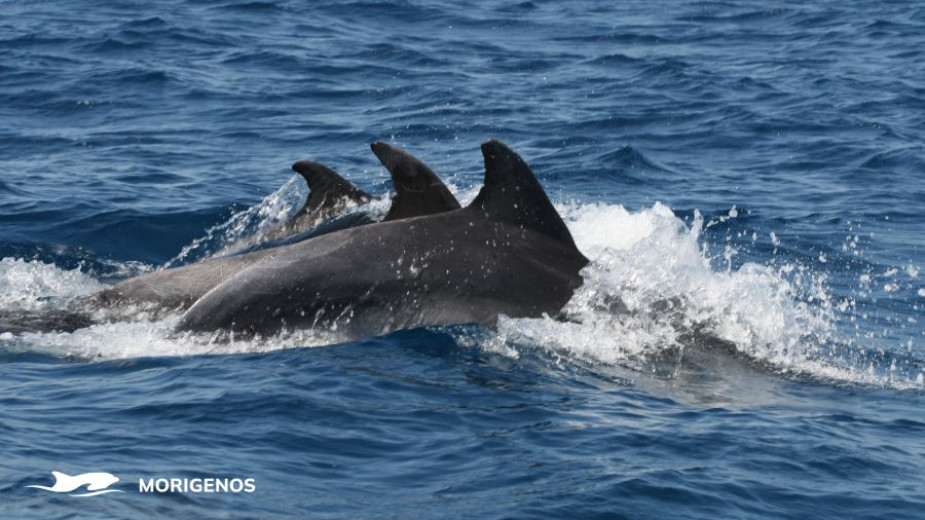 Sound is vital for dolphins — they use it to communicate, navigate, and hunt. Loud underwater noise disturbs them during rest, play, and mating, and makes it hard to communicate or find food. Photo: Morigenos
Sound is vital for dolphins — they use it to communicate, navigate, and hunt. Loud underwater noise disturbs them during rest, play, and mating, and makes it hard to communicate or find food. Photo: Morigenos
-
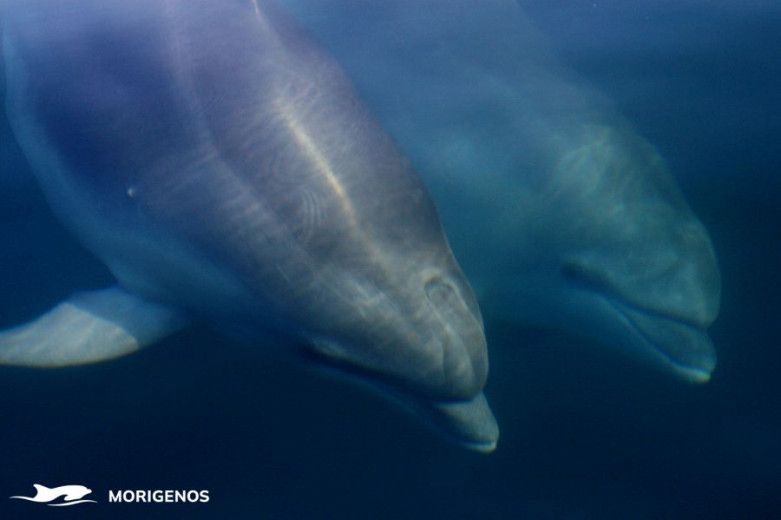 To protect the dolphins, we must reduce pollution and use fewer toxic substances. Photo: Morigenos
To protect the dolphins, we must reduce pollution and use fewer toxic substances. Photo: Morigenos
Dolphins are threatened by pollution too (toxic chemicals piling up in their bodies). They might mistake plastic waste for food. This leads to internal injuries and death.
Remember, dolphins are wild animals, whereas we are mere visitors of their natural habitat.
While many would like to see dolphins up close, experts suggest the opposite, proposing the curious to sail parallel to them at a distance of at least 100 metres. Do not chase or feed the dolphins, nor attempt to swim with them.

